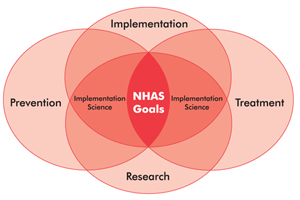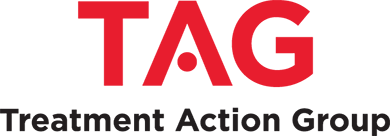President Obama orders multiagency cooperation to achieve National HIV/AIDS Strategy goals, but without required funding commitment
By Scott Morgan
If the United States is to effectively move toward the 2015 goals outlined in the National HIV/AIDS Strategy (NHAS) through the scale-up of evidence-based strategies and practices intended to maximize engagement in care and treatment outcomes, tighter collaboration between various federal agencies will be required. A critical step to accomplish this was made on July 15, when President Obama issued an executive order establishing the HIV Care Continuum Initiative, which mandates the creation of a working group that crosses federal agencies to work toward these goals.
An accompanying White House fact sheet further underscored the administration’s commitment to building capacity for community-based organizations and health departments, along with improvements in prevention and treatment integration across the HIV continuum of care, which begins with only 80 percent of those with HIV being aware of their status and ends with only one in four being effectively treated with antiretroviral therapy.
TAG issued recommendations in an action plan to revitalize the NHAS in April of this year, and it is heartening to see that many of those recommendations are reflected in the HIV Care Continuum Initiative and its associated efforts. Of concern, however, is the specified funding commitment, which falls considerably short of what’s needed to achieve NHAS goals, at least by 2015.
The HIV Continuum of Care Initiative
The Office of National AIDS Policy (ONAP) will oversee the initiative set forth by the president’s executive order; the ONAP Director will co-chair the working group with the secretary of health and human services (or her designate). Federal agencies participating in the initiative include the Department of Justice (DOJ), the Department of Labor (DOL), the Department of Health and Human Services (HHS), the Department of Housing and Urban Development (HUD), the Department of Veterans Affairs (VA), the Office of Management and Budget (OMB), and other agencies appointed by the co-chairs. The Presidential Advisory Council on HIV/AIDS (PACHA) will be consulted “as appropriate.”
The working group’s task is to gather information from these agencies on how to improve HIV testing, treatment, and care; to review potential research that can reduce gaps across the continuum; and to obtain input from affected communities and stakeholders that may improve outcomes. It is also intended to identify barriers and obstacles that particularly affect high-risk populations, devise ways to overcome the barriers, and better align efforts across federal agencies to move more rapidly toward the goals of the NHAS.
In a related effort, HHS will launch a new demonstration project, Integrating HIV Prevention and Care Services to Improve HIV Outcomes in Areas of High Unmet Need, designed to provide integrated prevention, treatment, and care throughout the treatment cascade. Another project aims to enhance the services and capacity of health care settings, revamp systems and procedures, institute better practices to identify those with the virus, and link clients to care so they can achieve and maintain an undetectable viral load.
Another demonstration project being mounted by the Centers for Disease Control and Prevention (CDC) is the Capacity Building Assistance for High Impact Prevention, which will run through March 2019 and will address gaps all across the continuum by providing information, training, and technical assistance for health departments, community-based organizations, health care organization, and capacity-building assistance/resource centers.
 Toward the Goals of the National HIV/AIDS Strategy (NHAS) The HIV Care Continuum Initiative, with its mandate for collaboration between various federal agencies to achieve the targets of the NHAS, will require the implementation of research-validated treatment and prevention strategies. This will require a commitment to a implementation science agenda to ensure adequate translation and evaluation of essential services in key populations and areas.
Toward the Goals of the National HIV/AIDS Strategy (NHAS) The HIV Care Continuum Initiative, with its mandate for collaboration between various federal agencies to achieve the targets of the NHAS, will require the implementation of research-validated treatment and prevention strategies. This will require a commitment to a implementation science agenda to ensure adequate translation and evaluation of essential services in key populations and areas.
Advocacy Priorities
The HIV Care Continuum Initiative and its related programs accord with with many of TAG’s recommendations in our April 2013 Revitalizing the U.S. National HIV/AIDS Strategy Action Plan, produced following a December 2012 meeting with advocates, service providers and researchers to review the current state of the national HIV response.
In particular, TAG recommended that ONAP coordinate the efforts of numerous federal agencies—the root of the Continuum Initiative—though we specifically note the importance of collaboration on the development of an implementation science research agenda. This agenda would guide the scale-up of evidence-based interventions to improve prevention, care, and treatment outcomes in populations facing important structural, behavioral, and cultural barriers to uptake (see Engagement in Care).
TAG also recommended that the Affordable Care Act (ACA) and Medicaid expansion be implemented efficiently, as the systems through which people with HIV currently receive prevention, care, and treatment are going to go through many changes—a potentially turbulent process at first. This recommendation ties to the CDC’s capacity-building prevention project, which will ensure that community-based and health care organizations have the skills and information to better achieve the goals of the NHAS throughout the ACA transition.
A significant recommendation coming out of TAG’s report is to reallocate investments in HIV prevention and care for better results, using an investment framework that targets those most in need and where limited resources will do the most good. The HHS demonstration project has the potential to shed light on where investments are most needed, thereby improving outcomes across the HIV care continuum in areas of high unmet need.
Whether we are talking about TAG’s recommendations or the executive order, community mobilization and activism will be critical, both in terms of working toward revitalizing the NHAS and ensuring that accurate and complete information is fed back to the working group so that needs, priorities, obstacles, and community perspective are given full consideration.
The Question of Funding
Significant new financial resources must be mobilized and invested to reduce new infections, eliminate health disparities, and improve health outcomes for people with HIV.
In a 2012 article, David Holtgrave, PhD, of the Johns Hopkins Bloomberg School of Public Health estimated that an additional $15.2 billion is required to reach some of the modest prevention and treatment targets set forth in the NHAS. However, the window of opportunity is rapidly closing, and there are no indications from the administration that these resources will be forthcoming. In fact, the proposed 2014 domestic HIV budget request is for $23.2 billion, a less than $2 billion increase from 2012.
A reevaluation of the original timeline is inevitable. At the same time, it will be critical to reevaluate the discrete targets within the goals of the NHAS. As Dr. Holtgrave recently pointed out in an August AIDS and Behavior commentary, “we propose bold yet achievable quantitative 2020 goals based on previously published economic and mathematical modeling analyses.”
As 2014 appears on the horizon, it is becoming clearer that the 2015 NHAS goals will remain out of reach. This administration must not simply kick the can down the road toward 2020, but rather engage fully in critical analysis and novel thought to formulate and achieve NHAS goals, relying on scientific evidence to drive sufficient funding.
The Obama administration’s commitment to making the NHAS more ambitious is in line with the latest science, with the opportunities provided by the Affordable Care Act, and with the U.S. activist community’s interest in ending the AIDS pandemic. The new Continuum of Care Initiative as laid out in the July 15 executive order is commendable on many levels, and there is reason to hope that investments in the demonstration projects outlined in the order will yield new evidence and insights that will not only propel the NHAS forward, but provide a basis from which to mobilize the required resources to end AIDS in the United States. •
